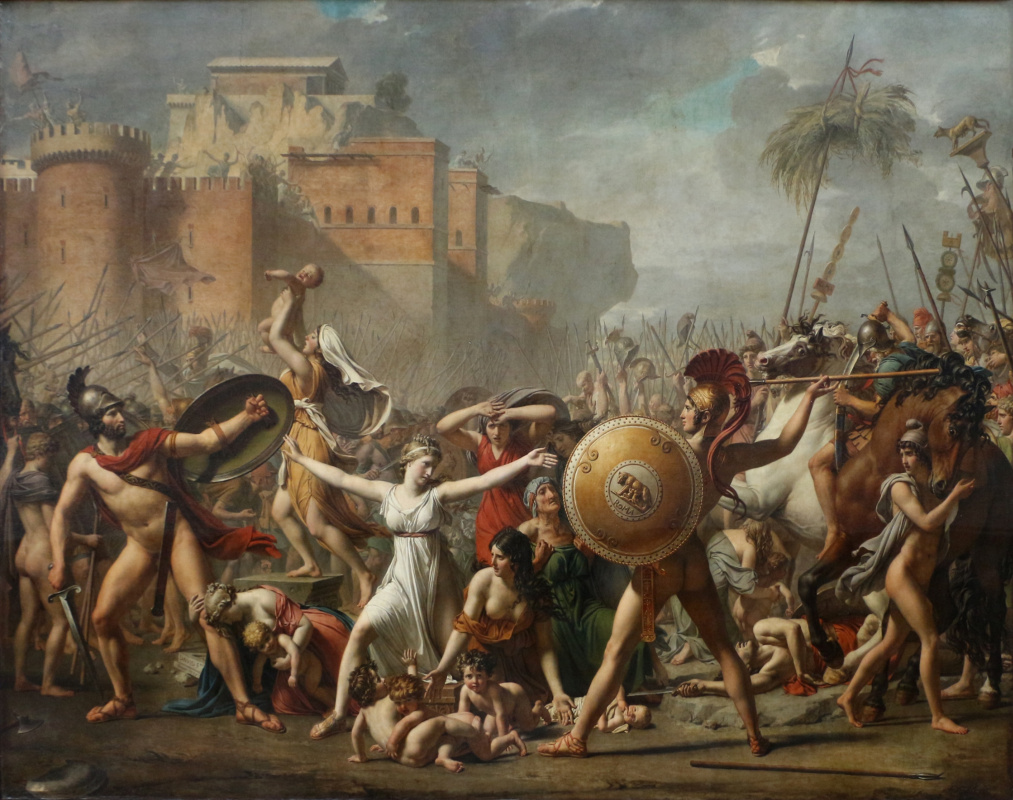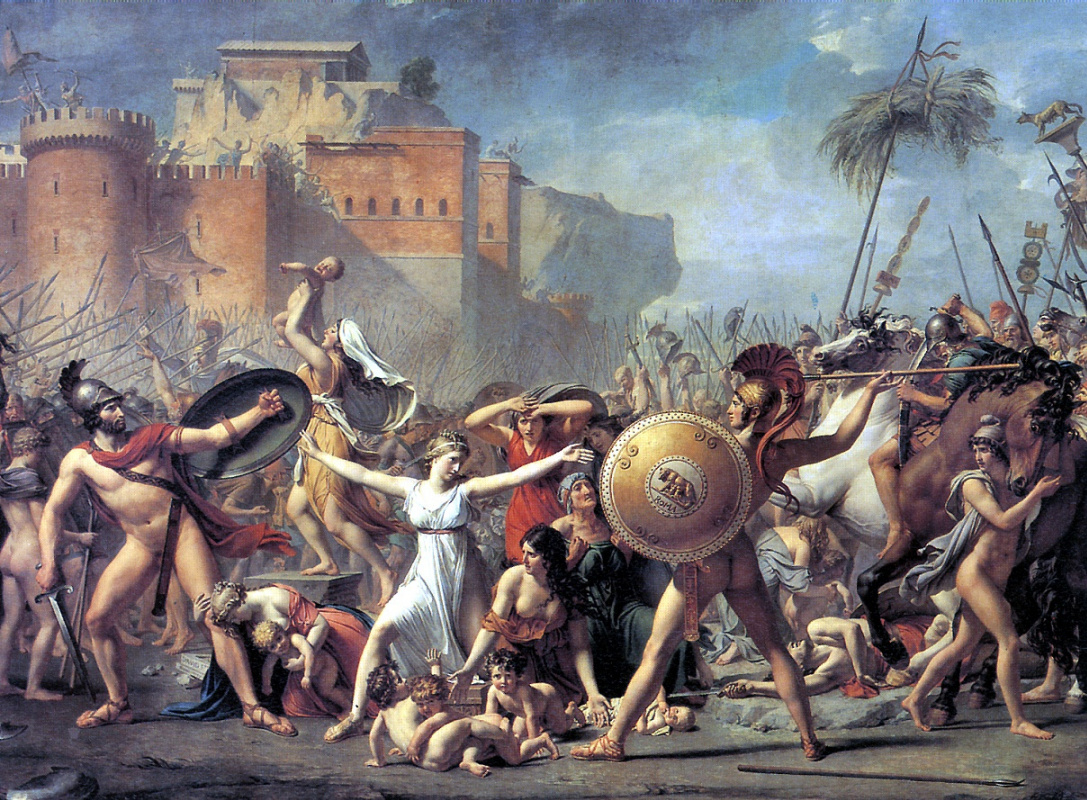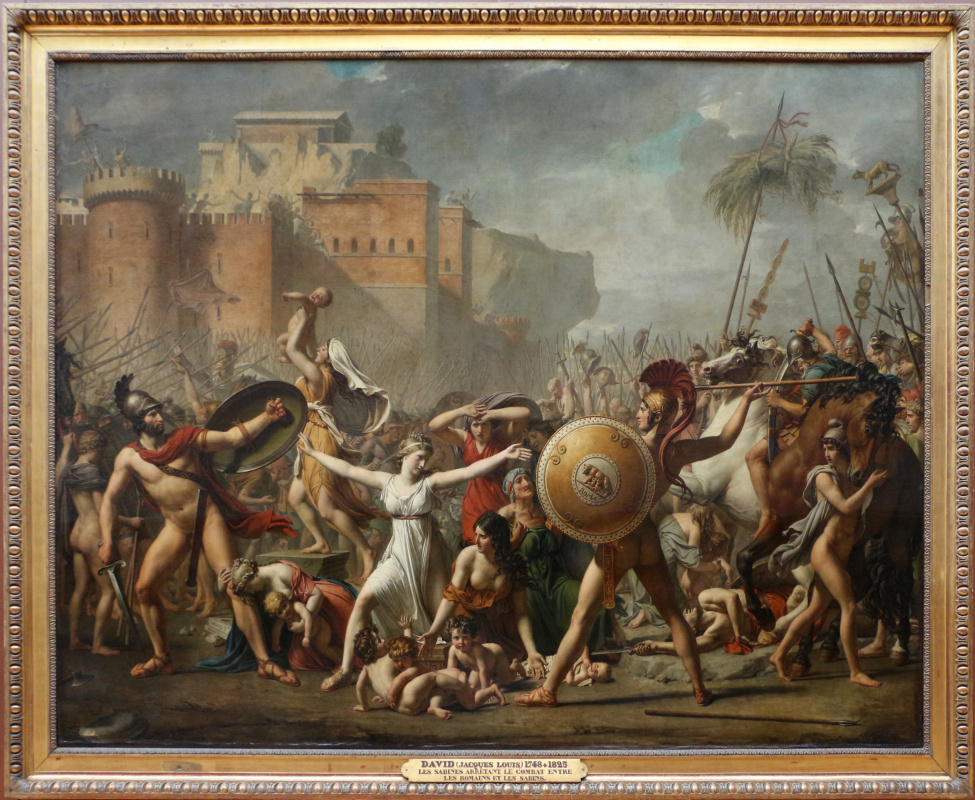log in
Enter site
Login to use Arthive functionality to the maximum
Sabine women stopping the battle between Romans and sabinyanami
Jacques-Louis David • 绘画, 1799, 385×522 厘米
画作描述 «Sabine women stopping the battle between Romans and sabinyanami»
The idea of large-scale paintings "Sabine women" visited by Jacques-Louis David when he was in prison. "Painter of the revolution", recently signing with other members of the Convention the death sentence to Louis XVI, and then headed to the Louvre, and with it the entire artistic life of France, after the fall of the Jacobin dictatorship he was a victim, locked up in a prison awaiting imminent execution.
But David was acquitted, although it had little hope. His wife Charlotte Pecoul, which went from the artist as soon as he learned that David was among those who decided to execute the king, did everything possible and impossible to her husband, though the former escaped the guillotine. Then they re-married and almost 30 years were together until the death of David in 1825 separated them.
After his release, David began the "rape of the Sabine women" painting, singing of universal reconciliation. To facilitate such a reconciliation, according to the idea of the picture, can only women who are just as committed and as entrepreneurial as Charlotte Pecoul.
The legend of the Sabine women David borrowed from the historical period, which loved most, – the early history of Rome. The town's founder, Romulus came up with a novel way to increase the population of the metropolis, who suffered from a lack of women. He made in Rome a feast to which were invited sabinyanami with their wives and unmarried daughters. On a prearranged signal, the Roman youths rushed into the crowd, snatched the girls of the Sabine women and have dragged them to his home. But this is only the beginning. By the way, in the picture "The rape of the Sabine women"it was captured by French painter Nicolas Poussin. But David, in his picture tells the story of what happened next. The Sabine has accepted his fate as inevitable: they were the wives of the Romans and gave birth to their children, as planned visionary Romulus (it can be found in "the Sabine women" in the image of the Capitoline wolf on the shield). However, the sabinyanami insulted by the act of the Romans, did not leave the plans of vengeance. And one day, when their army became stronger, they entered Rome.
The ensuing battle would end in a bloody massacre and mountains of corpses, but suddenly, on the battlefield appeared, the former captive. On the hands instead of shields they carried their little children. Women covered themselves Romans from the Sabines, and Sabines by the Romans. They appealed first to their fathers and brothers and the second to their husbands, "calling out their pet names"as Plutarch wrote. The Sabine called for peace. For strife-torn France of the time of David, as for Rome, nothing was more important than the call to civil agreement. This explains the conciliatory pathos of the paintings, and a Roman fortress in the background is not accidentally reminiscent of the towers of the Bastille.
Many figures paintings, the audience learned of their contemporaries: for the matriarch of the Sabine women of Hersilia and the kneeling woman in the foreground David posed for the most famous beauties of that time sisters Bellegarde, and the old woman behind them David wrote with the old nurse their own children. The wives of David is not on the picture, but she is dedicated to the "Sabine women". We know what she looked likethanks to a much later portrait in 1813, where Charlotte is depicted, perhaps, lost its former beauty, but wise and humane.
Anna Yesterday
But David was acquitted, although it had little hope. His wife Charlotte Pecoul, which went from the artist as soon as he learned that David was among those who decided to execute the king, did everything possible and impossible to her husband, though the former escaped the guillotine. Then they re-married and almost 30 years were together until the death of David in 1825 separated them.
After his release, David began the "rape of the Sabine women" painting, singing of universal reconciliation. To facilitate such a reconciliation, according to the idea of the picture, can only women who are just as committed and as entrepreneurial as Charlotte Pecoul.
The legend of the Sabine women David borrowed from the historical period, which loved most, – the early history of Rome. The town's founder, Romulus came up with a novel way to increase the population of the metropolis, who suffered from a lack of women. He made in Rome a feast to which were invited sabinyanami with their wives and unmarried daughters. On a prearranged signal, the Roman youths rushed into the crowd, snatched the girls of the Sabine women and have dragged them to his home. But this is only the beginning. By the way, in the picture "The rape of the Sabine women"it was captured by French painter Nicolas Poussin. But David, in his picture tells the story of what happened next. The Sabine has accepted his fate as inevitable: they were the wives of the Romans and gave birth to their children, as planned visionary Romulus (it can be found in "the Sabine women" in the image of the Capitoline wolf on the shield). However, the sabinyanami insulted by the act of the Romans, did not leave the plans of vengeance. And one day, when their army became stronger, they entered Rome.
The ensuing battle would end in a bloody massacre and mountains of corpses, but suddenly, on the battlefield appeared, the former captive. On the hands instead of shields they carried their little children. Women covered themselves Romans from the Sabines, and Sabines by the Romans. They appealed first to their fathers and brothers and the second to their husbands, "calling out their pet names"as Plutarch wrote. The Sabine called for peace. For strife-torn France of the time of David, as for Rome, nothing was more important than the call to civil agreement. This explains the conciliatory pathos of the paintings, and a Roman fortress in the background is not accidentally reminiscent of the towers of the Bastille.
Many figures paintings, the audience learned of their contemporaries: for the matriarch of the Sabine women of Hersilia and the kneeling woman in the foreground David posed for the most famous beauties of that time sisters Bellegarde, and the old woman behind them David wrote with the old nurse their own children. The wives of David is not on the picture, but she is dedicated to the "Sabine women". We know what she looked likethanks to a much later portrait in 1813, where Charlotte is depicted, perhaps, lost its former beauty, but wise and humane.
Anna Yesterday





